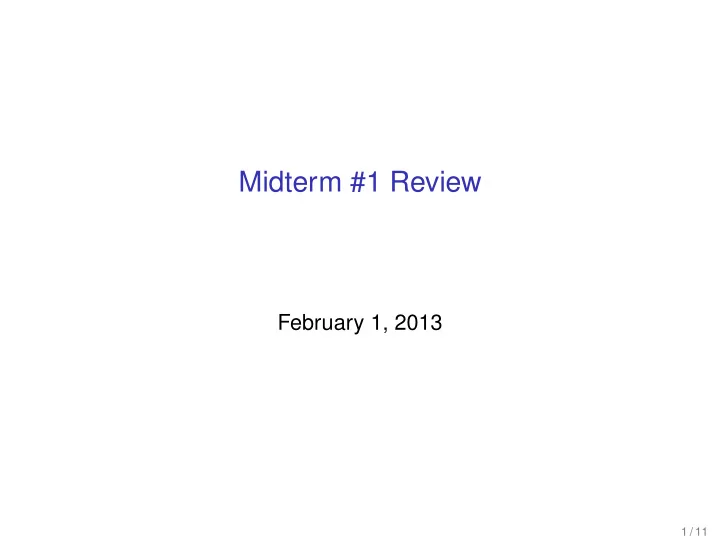

Midterm #1 Review February 1, 2013 1 / 11
I will provide . . . • ASCII character encoding table • powers of 2 up to 2 15 • a list of relevant instructions for assembly problems • just the names! • you should know the difference between: add and addi ; move , lw , sw , and la • the interfaces of relevant system calls 2 / 11
You should bring . . . • a pencil and eraser • one page of notes (optional) No calculator! 3 / 11
Structure of test Part 1: Computer architecture vocabulary • FDX cycle, datapath, control unit, bus • multiplexor, control signal, conditional signal, clock • program counter, instruction register, register file, ALU • memory, text segment, data segment Part 2: Representing integers and base conversion • decimal ⇔ binary • binary ⇔ hexadecimal • two’s complement representation 4 / 11
Structure of test Part 3: Representing strings • ASCII character encoding • null-terminated strings and null-padding • big-endian vs. little endian Part 4: Integer arithmetic • adding and multiplying signed integers (helpful to understand carryout vs. overflow) 5 / 11
Structure of test Part 5: MIPS assembly • encode math expressions as sequence of instructions • declare variables and constants in data memory • how to read and write memory ( lw and sw ) • how to use system calls 6 / 11
Representing integers and base conversion Assume all integers are signed and in big-endian form • Use two’s complement notation for negative numbers Exercises 1. Convert decimal 102 into an 8-bit integer in binary 2. Convert decimal -102 into an 8-bit integer in binary 3. Convert decimal -844 into a 16-bit integer in binary 4. Write decimal -844 as a 16-bit integer in hexadecimal 5. Convert signed 16-bit integer 0xFACE into decimal Powers of 2 0 1 2 3 4 5 6 7 8 9 10 n . . . 2 n 1 2 4 8 16 32 64 128 256 512 1024 . . . 7 / 11
Representing strings ASCII character encodings Assume 32-bit words and addressable bytes (as in MIPS) Encode “Aye, aye!” as a null-terminated ASCII string • using big-endian byte ordering • using little-endian byte ordering (Give each byte in hexadecimal) 8 / 11
Binary arithmetic Assume all numbers are signed, 8-bit integers For each arithmetic expression: 1. convert the arguments to binary 2. perform the operation on the binary representation 3. convert back to hexadecimal • 0x53 + 0x1B • 0xB3 + 0xE9 • 0x0B × 0x06 ← multiply! 9 / 11
Assembly programming # Pseudocode: # c = (a+3) * (b-2) + a # Register mappings: # a: $t0 # b: $t1 # c: $t2 Instructions you may need: • li , add , addi , sub , subi , mul • note: mul is a macro instruction that takes three registers: mul $t0,$t1,$t2 # hi,lo = $t1 * $t2; $t0 = lo • you can assume result is 32-bits ( hi = 0) 10 / 11
Assembly programming (solution) # Pseudocode: + # c = (a+3) * (b-2) + a # Register mappings: tmp3 # a: $t0, b: $t1, c: $t2 * a # tmp1: $t3, tmp2: $t4, tmp3: $t5 tmp1 + - tmp2 addi $t3, $t0, 3 # tmp1 = a+3 subi $t4, $t1, 2 # tmp2 = b-2 mul $t5, $t3, $t4 # tmp3 = tmp1 * tmp2 a 3 b 2 add $t2, $t5, $t0 # c = tmp3 + a Register optimization (optional) addi $t3, $t0, 3 # tmp1 = a+3 subi $t2, $t1, 2 # c = b-2 mul $t2, $t3, $t2 # c = tmp1 * c add $t2, $t2, $t0 # c = c + a 11 / 11
Recommend
More recommend